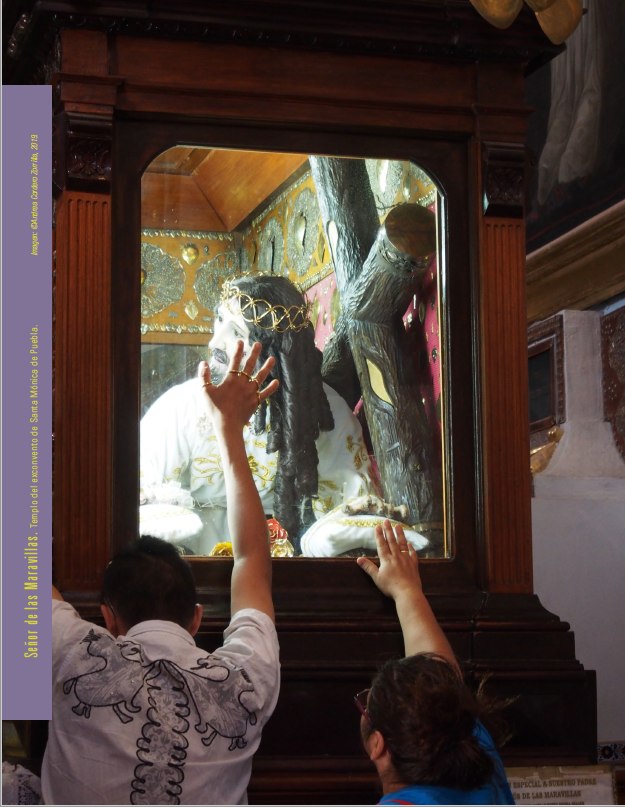Y se burlarán de Él y le escupirán, le azotarán y le matarán, y tres días después resucitará. Origen de la escultura del Señor de las Maravillas de la ciudad de Puebla

Published 2019-12-16
Keywords
- Señor de las Maravillas,
- sculpture,
- exconvento de Santa Mónica,
- Puebla
How to Cite
Abstract
The polychrome sculpture Señor de las Maravillas (Lord of Marvels) belongs to the temple within the former convent of Santa Monica in the city of Puebla. It is a highly popular statue and subject of a widespread devotion among catholic groups, not only in the state of Puebla, but throughout the country, and even with immigrants that often go visit it to ask for miracles and indulgences. Around this sculpture there is a whole devotional and anthropological henomenon, but little is known its historical backround and iconography. Because of that this work is aimed to track -from the formal and iconographic point of view- the origin of its denomination, by using graphic, pictorial and sculptural sources of European conception, produced during the Viceroyalty in México, as expressions impulsed by the eclessiastical and theological canons from the time. From this investigation, it was possible to find the original dedication. It can be confirmed that the dedication has European reminiscences, but that it was particularly spread in American and New Spain’s territory and, today, it has reconfigured within the society and has taken new forms of aesthetic and simbolic expression.
Downloads
References
- Agreda, María de Jesús (1670) Mística Ciudad de Dios. Milagro de Su Omnipotencia y abismo de la Gracia. Historia
- Divina, y vida de la Virgen Madre de Dios, Reina y Señora Nuestra, María Santísima, Restauradora de la culpa de
- Eva y medianera de la Gracia [pdf], disponible en: <https://aparicionesdejesusymaria.files.wordpress.com/2011/06/madre-marc3ada-de-jesc3bas-de-c3a1greda-mc3adstica-ciudad-de-dios-1670.pdf> [consultado el 25 de junio de 2019]
- Fernández Paradas, Antonio Rafael, y Sánchez Guzmán, Rubén (2012) Orígenes, desarrollo y difusión de un modelo
- iconográfico. Jesús recogiendo sus vestiduras después de la flagelación (siglos XV-XX), Tenerife, Sociedad Latina de
- Comunicación Social (Cuadernos de Bellas Artes, 4).
- González Gómez, Miguel (2000) "Una obra inédita de Lorenzo Cano: Jesús del mayor dolor de Écija", Laboratorio de
- Arte: Revista del Departamento de Historia del Arte (13): 193-206.
- Jiménez Medina, Luis Arturo (2013) "El culto al Señor de las Maravillas, una expresión de religiosidad popular de tipo urbano en la ciudad de Puebla", Cuicuilco, 20 (57): 279-295.
- Quintana Echeverría, Iván (2000) "Notas sobre comercio artístico entre Sevilla y América en 1586", Anales del Museo de América, 8: 103-110.
- Sánchez López, Juan Antonio (1995) “Imago Imaginis. Un ejemplo de propaganda visual bajo las ópticas popular y
- culta", Baética: Estudios de Arte, Geografía E Historia (17): 31-52.
- Solis Hernández, Agustín (2004) Obra mariana de la colección pictórica del museo de arte religioso e convento de Santa Mónica, tesis de licenciatura en Historia, Puebla, Benemérita Universidad Autónoma de Puebla.
- Soroche Cuerva, Miguel Ángel (2012) "Una iconografía andaluza en Iberoamérica: Jesús recogiendo sus vestiduras”, Quiroga. Revista de Patrimonio Iberoamericano (1): 42-56.
- Vázquez Ahumada, María Cecilia de la Paz (2010) Los patrimonios artísticos regionales reclaman ser estudiados. El
- caso del Museo de Arte Religioso del ex Convento de Santa Mónica de Puebla, tesis de maestría en Historia del Arte, Ciudad de México, Universidad Nacional Autónoma de México.

